![]()
![]()
![]()
Use LEFT and RIGHT arrow keys to navigate between flashcards;
Use UP and DOWN arrow keys to flip the card;
H to show hint;
A reads text to speech;
40 Cards in this Set
- Front
- Back
- 3rd side (hint)
|
Pituitary Gland |
Located in the sella turcica of the sphenoid in the skull, inferior to the hypothalamus of the brain Also known as the hypophysis |
|
|
|
Infundibulum |
The connection between the pituitary and the hypothalamus |
|
|
|
Negative feedback loop |
A stimulus ( hot air ) causes a response (turn on the AC) which lowers or removes the stimulus ( cool room makes the AC turn off) Negative feedback is a self limitting mechanism |
|
|
|
Exocrine Glands |
Secretes, substances into ducts for transport and releases it on to a free surface on the body Ex: sweat glands and sebaceous glands of the skin |
|
|
|
Endocrine glands |
Produces regulatory molecules called hormones that slowly change the metabolic activity of target cells which os any cells thats contain membrane receptor for that specific hormone Endocrine glands are duck less, they don't secrete into ducks but into extra cellular fluid |
|
|
|
What are the two systems that regulate homeostasis ? |
The nervouse system and endocrine system. Nervous - short term, fast "ER" response in milliseconds Endrocrine- long term, "slow" response in hours or days |
|
|
|
Posterior Pituitary |
Also known as the neurohypophysis or pars nervosa Made of neural tissues that receives, stores and releases hormones from the hypothalamus ( ADH &OT ) Made of : Unmyelinated axons: that stain light Pituicytes: scattered in the lobe function is similar to glia cells. Stain darker |
|
|
|
Anterior Pituitary |
Also know as adenohypophysis or pars distalis which isnthe msin portion of the anterior lobe Made of glandular tissue and makes owne hormones Made up of: Chromophobes: light fear- dont stain very well Chromophils: light lovers- react to most stains. Acidophils : reddishbrown Basophils: deep blue |
|
|
|
Pars intermedia |
Separate the anterior and posterior pituitary Produces melanocyte stimulation hormone (MSH) |
|
|
|
Hypothalamus |
Produces regulatory hormones that release ( GH-RH) or inhibit (GH-HI) the activity of the anterior pituitary gland
Also praduces antidiuredic hormone and oxytocin that are stored in the posterior pituitary |
|
|
|
Why is the pituitary gland often refer to as the master gland? |
Because of its regulatory endocrine function and ots production of hormones that control other endocrine glands |
|
|
|
Thyroid gland |
Located in the anterior aspect of the neck under the thyroid cartilage ( Adam's apple ) The thyroid affects pretty much everything in the body because is not a lock and key mechanism but rather systematic Produces thyroid hormones T3 ( fire) and T4 ( wood) and calcitonin ( by c cells ) |
|
|
|
Isthmus |
Central mass that connects the two thyroid lobes |
|
|

C cells |
Parapgollicylar cells, light stain that are larger and less abundant located on the margin of follocles in the CT. The c cells produce calcitonin which decreases calcium levels in the blood by stimulation osteoblasts to store calcium in bone tissue and inhibit osteoclasts ( minor role in humans ) Antagonist to PTH |
|
|
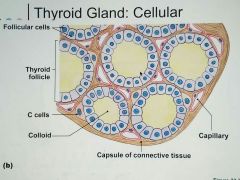
Follicle cells ( follicular cells) |
Single layer of simple cuboidal epithelia that surrounds the thyroid follicle |
|
|
|
Thyroglobulin |
Lumen that fills each follicle is a glycoprotein that stores T4 and T3 |
|
|
|
Thyroxine T4 and Triiodothyronine |
Consists of two thyrosine molecules plus 4 iodide molecules. Most important in maintaining the metabolism Consists of two thyrosine molecules and 3 iodide molecules TSH produced by the anterior pituitary starts the production of T4 and T3 They are synthezised in the form of the glycoprotein thyroglobulin that is secreted into the lumen of the follicle and stored until the body needs it. |
|
|
|
Fuctions of the thyroid hormone |
Increase body tempeture through elevation of oxygeb and energy consumption. Increase blood pressure and heart rate Increases sensitivity to sympathetic stimulation Enhance oxygen delivery by stimulating red blood cell formation Activates genes to produce enzymes for glycolysis Increases ATP production AFFECTS EVERYTHING basically the metabolism and cellular oxidation. Produces by follicular cells |
|
|
|
Hypothyroidism |
Myxedema-physical and mental sluggishness. The anterior pituitary is producing A LOT of TSH but the thyroid is underutilizing it therefore the levels of TSH are elevated but the thyroid levels are low. Hypo on thyroid( not enough thyroid hormone production ) not pituitary |
|
|
|
Hyperthyroidism |
Nervouseness, irregular heart beat and weight loss.
The levels of TSH from the anterior pituitary are low because the thyroid is producing A LOT of thyroid hormones Hyper on the thyroid not the anterior pituitary |
|
|
|
Parathyroid glands |
Tiny glands located on the posterioe aspect of the thyroid ( two each side ) Secretes PTH ( parathyroid hormone). Which acts opposite to calcitonin in that it releases calcium into the blood |
|
|
|
3 ways to release parathyroid hormone into the blood. |
Stimulation of osteaclasts to digest bone matrix Reabsorption in the kidneys Reabsorption by intestines by the activation of Vit D |
|
|
|
Hyperparathyroidism |
Bone deformity and fractures. Too much calcium in the blood |
|
|
|
Hypoparathyroidism |
Low levels of calcium in the blood can lead to cramping and twitchubg of the muscles along with interferance in neural connections Tetany ( twitchy) |
|
|
|
The parathyroid |
It is surrounded by a fibrouse capsule that separates it from the thyroid Cheif cells: darker stain with round nucleus arrange in clusters that produce PTH hormone Oxyphil cells: larger than chief cells and more scattere they stain colorless |
|
|
|
Thymus glands |
Posterior to the sternum inferior to the thyroid in the thoracic cavity Gets smaller as one gets older. In charge of the immune system therefore isnmore active in chidren than adults
|
|
|
|
Thymus hormones and the immune system |
Thymoproietins and thymosins which are essenssial for the production of T lymphocytes which is a type of WBC that fights off foreign grafts, tumors or viruse infected cells. Tymosin is essensial in the development amd maturation of the immune system |
|
|
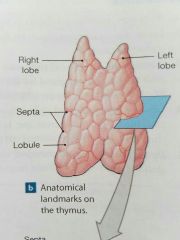
Thymus anatomy |
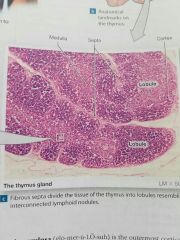
The thymus gland is organized into two main lobes made of LOBULES: very small lobes. The lobules are seoarated by SEPTAE: fibrouse CT . The lobules is made of a dense CORTEX: which is made of reticular cells that secrete the thymic hormones. And CENTRAL MEDULLA: whuch is made if other retucular cells that come together into ocal mases to form thymis courpuses( tornatoes) which are surrounded by developing lymphycytes that will eventually enter the blood |

|
|
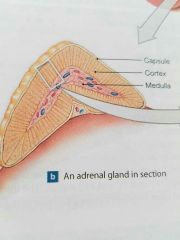
Adrenal gland |
Superior to the kidneys it is protectes by the adrenal capsule and attaches it to the kidney. Is os broken down into the adrenal cortes and adrenal medulla |
|
|
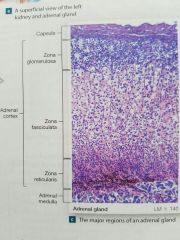
Adrenal cortex |

Glandular tissue that produces corticosteroids Zona glomerulosa: outer most spherical cluster of cells that secrete mineralcorticoids( regulate minerals or electrolytes in the body, aldosterone ) Zona fasciculate: next layer, cells are arranged in parallel cords, secrete glucocorticoids( involved in fighting stress, increase glucose metabolism and prevent inflamation, cortisol is the most important helps maintain stress low and resist chromic stress by keeping the sugar levels constant Zona reticularis: inner most later of the adrenal cortex. Cells are arranged in branches and in produces gonadocorticoids mainly sex hormones ( androgens ) |
|
|

Adrenal medulla |
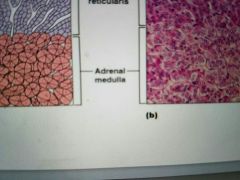
Responsible for fight or flight It is regulated by the hypothalamus sympathetic neurons.
Secretes epinephrine and norepinephrine which are necessary to adapt to stress and response fast
Over time the adrenal gland is ruin because of chronic stress |
|
|

Pancreas |
A traingular glandular organ that lies posterior to the stomach Lots of important exocrine ( the cells secrete digestive enzymes, buffers, and other molecules into a pancreatoc duct that empties into the small intestine) and endocrine( cells that secrete insulin to regulate blood sugar metabolism ). |
|
|
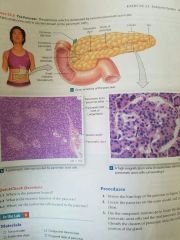
Pancreatic acini |
These cells make up the exocrine part of the pancreas and the secrete pancreatic juices like enzymes( hydrolytic enzymes) and stain dark |
|
|
|
Pancreatic islets |
The endocrine cells if the pancreas occure in isolated clusters ( islets of langerhans) they are made of four types of cells, alpha beta delta amd f cells. Most important are alpha which produce glucagon and beta which praduce insulin |
|
|
|
Glucagon |
Secreted by alpha cells. Glucagon raises blood sugar levels by catabolizing glycogen to glucose for cellular respiration this is called glycogenolysis |
|
|
|
Insulin |
Secreted by beta cells which accelerate glucose uptake by the cells to get it out of the blood and lower sugar levels. Accelerates glycogenesis |
|
|
|
Diabetes mellitus |
Glucose in the blood cant enter the cells and blood levels rise |
|
|
|
Type 1 diabetes |
Hyposecretion of insulin, beta cells are unable to produce enough insulin and cells are nit stimulated to take in glucose. These people take unsuñin to regulate their blood sugar levels hypersecretion of insulin - low blood sugar levels hypoglycemia |
|
|
|
Type 2 diabetes |
Cells becomes less responsive to insulin insulin resistance. The pancreas produces enough insulin but the body is not resposive to it. This results in high levels of glucose |
|
|
|
Pineal gland |
Small gland hanging from the roof of the third ventricke of the brain Produces melatonine that is involve in the day night cycles and physiological processes that regulate rythmic variations ( body temperature, sleep, appetite Known as thw 3 eye - senses light and activity during sleep for protection Tryptiphan -seritonine-melatonine |
|

